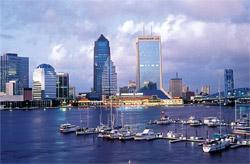At 885 square miles, Jacksonville, Florida, is geographically the largest city in the continental United States. It currently ranks as the eleventh most populous city in the nation and the largest in Florida, with more than 825,000 people. According to the 2010 U.S. Census, Jacksonville is 55 percent white, 31 percent African-American, 8 percent Latino, and 4 percent Asian. In comparison to the state as a whole, Jacksonville has very different demographics, with twice the percentage of African-Americans and Asians but a third the proportion of Latinos. In 2011, residents elected Alvin Brown as Jacksonville’s first African-American mayor.
In 2011, Forbes ranked Jacksonville as one of the top ten best cities for technology jobs and Bloomberg Businessweek rank it fourth for cities with the biggest growth in technology jobs. The city has also been ranked by Forbes in 2011 as one of the best in the nation for minority entrepreneurs; according to the U.S. Census Bureau more than a quarter of all businesses are minority-owned and nearly 30 percent are majority women-owned. Jacksonville also ranks as one of the best cities for young professionals to live and work.
At every level in Jacksonville – from the city- and region-wide to the most grassroots of efforts – community wealth building initiatives exist and are being implemented. Municipal enterprises are especially important to the city’s economy: JEA (formerly Jacksonville Electric Authority) is the seventh-largest municipally owned electric utility in the country and largest in the state, serving nearly 420,000 customers across a 900-square-mile service area. In 2011, the company had more than $2 billion in total revenue and nearly $2 billion in assets.
The Port of Jacksonville is also an important economic engine for the city, owned and operated by an independent government agency called the Jacksonville Port Authority (JAXPORT). A 2009 study estimated that 65,000 jobs in Northeast Florida are related to port activity and that the Port generates nearly $19 billion in economic impact annually. The Port’s current expansion project is expected to create an additional 5,000 to 10,000 new jobs. Furthermore, JAXPORT has made commitments to supporting the regional economy of Northeast Florida by implementing a Small and Emerging Business Program, which includes a focus on minority suppliers.
Several municipal and community efforts have been specifically focused on place-based revitalization efforts in the city’s especially hard-hit northwest neighborhoods. Metro North Community Development Corporation (CDC) and Northwest Jacksonville CDC are two neighborhood organizations focused on commercial redevelopment and housing rehabilitation in the area. City leadership has also turned its attention toward these neighborhoods through a Neighborhood Stabilization Program focused on providing affordable housing for families in three specific zip codes. The city has also created the Northwest Jacksonville Economic Development Fund (NWJEDF), a public fund that can provide up to 25 percent of a total project cost for existing or prospective businesses seeking to expand in the targeted Northwest Jacksonville area.
Jacksonville’s historic neighborhoods also highlight the city’s community wealth building efforts. With more than 84 community gardens and the state’s largest and longest-running farmer’s market, Jacksonville strives for local growth through a variety of strategies. As result of the consolidation of Jacksonville in 1968 – which combined the city proper and county – local organizations have reacted by collaborating in various ways due to the large size of the city, including creating many regional associations and organizations. One such initiative is known as GoLO Jacksonville. GoLO manages a blog authored by various participating neighborhood associations to encourage residents to avoid malls and instead buy from locally owned and operated businesses in Jacksonville’s seven historic neighborhoods.
An overview of community wealth building efforts follows:








